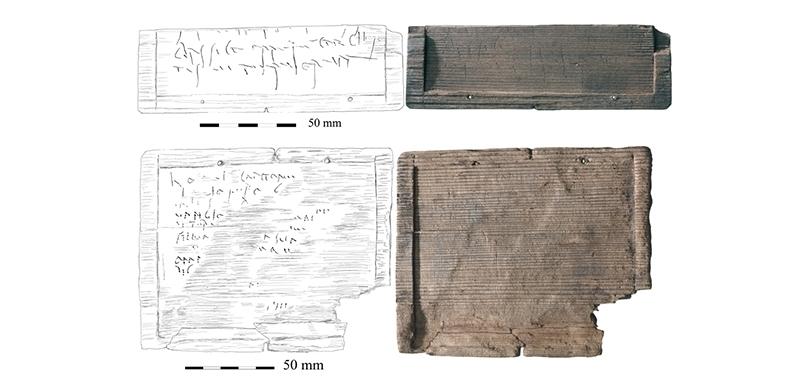Bloomberg writing tablets displayed for the first time in ‘Nero: the man behind the myth’ at The British Museum
Three Roman writing tablets are set to go on display in the upcoming British Museum exhibition ‘Nero: the man behind the myth’, two of which have never before been shown to the public.
The artefacts are part of a collection of over 400 wooden tablets discovered by MOLA archaeologists during archaeological excavations for Bloomberg’s European headquarters in London. Among these were the first hand-written document known from Britain and the earliest reference to London by name. The tablets’ recesses were once filled with wax for scratching writing into using a stylus – the marks we see today are the results of inscribers pressing too hard, into the wood below.
Inscriptions on the two tablets debuting at the British Museum in May make reference to two cohorts of soldiers – the Nervii and Vangiones – sent by Emperor Nero from Germany to Britain as reinforcements in AD 61, in the wake of the Boudiccan revolt (when British tribes mounted an armed uprising against Roman authority, 18 years after the Roman invasion). The reinforcements came from the Rhine frontier, which was the nearest other heavily militarised zone of the Roman Empire. Most of the original invasion force was also drawn from this region.
One tablet refers to ‘the First Cohort of Vangiones’, while the other names ‘Classicus, prefect of the Sixth Cohort of Nervii’ – thought to be Julius Classicus, an equestrian officer and nobleman from Trier in Germany. Interestingly, in AD 69/70, only ten years or so after the revolt of Boudicca, Julius Classicus was one of the leaders of the 'Batavian Revolt' – an uprising by a Germanic tribe against the Romans on the Rhine – despite being a Roman officer and related to Classicianus, a procurator (official in charge of financial affairs) whose tombstone is in the British Museum.

The third tablet is the oldest handwritten document from Britain and has been borrowed from its permanent display at the London Mithraeum. It mentions Nero in his role as consul, and records a debt:
“In the consulship of Nero Claudius Caesar Augustus Germanicus for the second time and of Lucius Calpurnius Piso, on the 6th day before the Ides of January (8 January AD 57). I, Tibullus the freedman of Venustus, have written and say that I owe Gratus the freedman of Spurius 105 denarii from the price of the merchandise which has been sold and delivered. This money I am due to repay him or the person whom the matter will concern …”.
The tablet pre-dates the Boudiccan revolt and supports the picture of London at this time being ‘very full of businessmen and commerce’ that Tacitus paints in his ‘Annals’.

While the tablet is on display at the British Museum, it has been temporarily replaced in the London Mithraeum by a 3D-printed replica which visitors will be able to handle.
The tablets will be on display in the British Museum exhibition ‘Nero: the man behind the myth’ from the 27 May - 24 Oct 2021. Tickets are available on the British Museum website. To find out more about the Bloomberg writing tablets and other incredible archaeological finds from the Bloomberg site, head to the London Mithraeum.